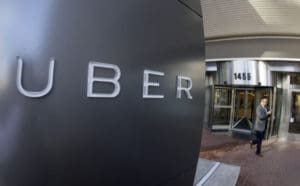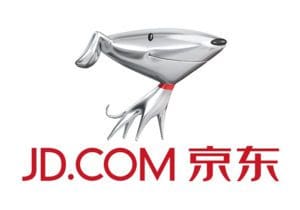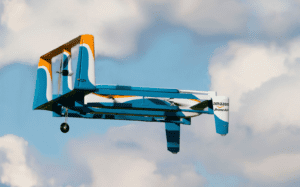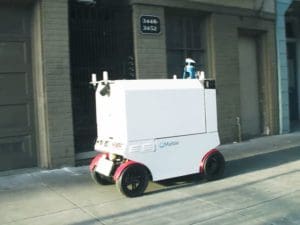 As I work to finish up my latest Transportation Management Systems Market Study, one thing is becoming clear: the cloud is in. This applies to basically all software applications these days as more and more suppliers are offering cloud solutions, and more and more customers are demanding them. For my latest study, cloud revenues have soared past those of on-premise solutions. This wasn’t always a given, as a lot of customers were wary about shifting away from an on-premise solution to a cloud solution. I’ll have more on this topic at a later date, but it is safe to say that customers are winning with the cloud. For that reason, I found it quite fitting that at last Saturday’s Preakness Stakes, in a shocking upset, Cloud Computing took home the victory over reigning Kentucky Derby Champion Always Dreaming. Cloud Computing took the lead in the final 1/16th of a mile and held on for a historic victory. I guess the lesson is that we should all bet on cloud computing.
As I work to finish up my latest Transportation Management Systems Market Study, one thing is becoming clear: the cloud is in. This applies to basically all software applications these days as more and more suppliers are offering cloud solutions, and more and more customers are demanding them. For my latest study, cloud revenues have soared past those of on-premise solutions. This wasn’t always a given, as a lot of customers were wary about shifting away from an on-premise solution to a cloud solution. I’ll have more on this topic at a later date, but it is safe to say that customers are winning with the cloud. For that reason, I found it quite fitting that at last Saturday’s Preakness Stakes, in a shocking upset, Cloud Computing took home the victory over reigning Kentucky Derby Champion Always Dreaming. Cloud Computing took the lead in the final 1/16th of a mile and held on for a historic victory. I guess the lesson is that we should all bet on cloud computing.
And now, on to the news.
- Uber launches Uber Freight, its app for long-haul trucking jobs
- Descartes pays $14 million for e-commerce fulfillment firm ShipRush
- Drones in the news:
- Adidas aims to eliminate slavery from tis supply chain
- Weather Co. launches ground-transport weather dashboard
- San Francisco tries to ban delivery robots
- Air cargo growth at fastest pace since 2010
 The wait is over as Uber has officially launched Uber Freight, its digital freight matching service. The app will match truckers with available capacity to companies that need to ship freight throughout the United States. Drivers, once they have signed up, will be vetted before they are allowed to use the service. Uber is trying to make the service as easy to use as its ride-hailing service; it provides a list of available jobs, the routes they require, what the driver will be hauling, and how much they will be paid. Challenges abound in the digital freight matching space, however, which can make scalability a tough obstacle to overcome. Unlike a lot of start-ups in the space, Uber has the name recognition, deep pockets, and the technology know-how to position itself properly. It will be interesting to see how the market responds.
The wait is over as Uber has officially launched Uber Freight, its digital freight matching service. The app will match truckers with available capacity to companies that need to ship freight throughout the United States. Drivers, once they have signed up, will be vetted before they are allowed to use the service. Uber is trying to make the service as easy to use as its ride-hailing service; it provides a list of available jobs, the routes they require, what the driver will be hauling, and how much they will be paid. Challenges abound in the digital freight matching space, however, which can make scalability a tough obstacle to overcome. Unlike a lot of start-ups in the space, Uber has the name recognition, deep pockets, and the technology know-how to position itself properly. It will be interesting to see how the market responds.
 Descartes, is continuing with its growth by acquisition strategy. After a busy 2016, in which the company acquired pixi, Apterra, 4Solutions, and Datamyne, the company has announced its first acquisition in 2017 – ShipRush. ShipRush is a provider of e-commerce multi-carrier parcel shipping solutions for small-to medium-sized businesses. The company essentially helps customers execute parcel shipments for last mile deliveries. According to Descartes, the acquisition will extend the reach of its network by integrating with additional e-commerce platforms while enhancing their parcel shipping functionality. Descartes will pay $14 million in up-front cash, plus a potential $3 million in performance-based bonuses to be paid by 2020.
Descartes, is continuing with its growth by acquisition strategy. After a busy 2016, in which the company acquired pixi, Apterra, 4Solutions, and Datamyne, the company has announced its first acquisition in 2017 – ShipRush. ShipRush is a provider of e-commerce multi-carrier parcel shipping solutions for small-to medium-sized businesses. The company essentially helps customers execute parcel shipments for last mile deliveries. According to Descartes, the acquisition will extend the reach of its network by integrating with additional e-commerce platforms while enhancing their parcel shipping functionality. Descartes will pay $14 million in up-front cash, plus a potential $3 million in performance-based bonuses to be paid by 2020.
 While many retailers have been testing drones for last mile deliveries, JD.com is looking at the big picture. Aside from building out plans to develop 150 drone operation sites, the Chinese e-commerce provider has announced that it is developing heavy-duty drones that will be capable of making deliveries weighing more than one ton via drone. These drones are not just about last mile delivery; they will can work the opposite direction as well. According to Josh Gartner, a JD.com spokesman, one example of the drone’s use is for farmers looking to reach far-off urban markets. Instead of using traditional modes of transportation, which could take longer and cause spoilage, farmers could quickly ship the produce by drones. JD.com will have to figure out some of the finer details for this venture, such as take-off and landing locations for large scale drones.
While many retailers have been testing drones for last mile deliveries, JD.com is looking at the big picture. Aside from building out plans to develop 150 drone operation sites, the Chinese e-commerce provider has announced that it is developing heavy-duty drones that will be capable of making deliveries weighing more than one ton via drone. These drones are not just about last mile delivery; they will can work the opposite direction as well. According to Josh Gartner, a JD.com spokesman, one example of the drone’s use is for farmers looking to reach far-off urban markets. Instead of using traditional modes of transportation, which could take longer and cause spoilage, farmers could quickly ship the produce by drones. JD.com will have to figure out some of the finer details for this venture, such as take-off and landing locations for large scale drones.
 Wilhelmsen Ships Service (WSS), one of the world’s largest ship agencies, is launching a pilot program to use drones to transport supplies to ships at anchor. The impetus behind the move is to reduce costs while servicing ships quicker. Traditionally, launch boats would shuttle documents, medical supplies, or other items to the anchored ships, at a cost of about $1500 per trip. WSS estimates that drones would not only get these supplies to the ships faster, but would also cost about 1/10th the price. The drones would able to carry about 5 – 25 lbs. of goods per trip.
Wilhelmsen Ships Service (WSS), one of the world’s largest ship agencies, is launching a pilot program to use drones to transport supplies to ships at anchor. The impetus behind the move is to reduce costs while servicing ships quicker. Traditionally, launch boats would shuttle documents, medical supplies, or other items to the anchored ships, at a cost of about $1500 per trip. WSS estimates that drones would not only get these supplies to the ships faster, but would also cost about 1/10th the price. The drones would able to carry about 5 – 25 lbs. of goods per trip.
 Continuing on the topic of drones, Amazon’s development of drone technology is advancing to the point where the company is now thinking about another major hurdle to overcome – geese. That’s right, geese. The company said it has begun developing an air-traffic control system for drones as they deliver goods from warehouses to consumers. Amazon created a new research and development team near Paris that is focused on building a system to ensure drones do not collide with any obstacles. While buildings and trees are on the list, they are a predictable obstacle. Birds on the other hand, are not. The drones will be programmed with instructions on how to react if they come near, or strike, a bird. This is one obstacle I had not even considered in the evolution of the drone market.
Continuing on the topic of drones, Amazon’s development of drone technology is advancing to the point where the company is now thinking about another major hurdle to overcome – geese. That’s right, geese. The company said it has begun developing an air-traffic control system for drones as they deliver goods from warehouses to consumers. Amazon created a new research and development team near Paris that is focused on building a system to ensure drones do not collide with any obstacles. While buildings and trees are on the list, they are a predictable obstacle. Birds on the other hand, are not. The drones will be programmed with instructions on how to react if they come near, or strike, a bird. This is one obstacle I had not even considered in the evolution of the drone market.
 Slavery and child labor within the global supply chain has become a front and center issue lately, as more consumer goods companies admit that their supply chains may be compromised. This is mostly due to the outsourcing of many processes. Adidas, the German sportswear company, has hired Aditi Wanchoo to combat the issue for the company. Wanchoo said Adidas had been actively working on issue since the 1998 World Cup where it was revealed that child laborers in India were manufacturing the soccer balls. The company urges workers to speak up and use this information to eradicate slavery and improve workers’ conditions. This is certainly a step in the right direction, and one that hopefully more global brands will embrace.
Slavery and child labor within the global supply chain has become a front and center issue lately, as more consumer goods companies admit that their supply chains may be compromised. This is mostly due to the outsourcing of many processes. Adidas, the German sportswear company, has hired Aditi Wanchoo to combat the issue for the company. Wanchoo said Adidas had been actively working on issue since the 1998 World Cup where it was revealed that child laborers in India were manufacturing the soccer balls. The company urges workers to speak up and use this information to eradicate slavery and improve workers’ conditions. This is certainly a step in the right direction, and one that hopefully more global brands will embrace.
The Weather Company, which is part of IBM, introduced a new weather dashboard which delivers real-time information for planning purposes to drivers, dispatchers and distribution-center managers. The dashboard includes information on weather and road conditions, which includes precipitation, wind, fog, ice, and pooling water. This allows dispatchers to change routes according to the dangerous weather conditions or traffic-related issues caused by the weather. Drivers also receive location-based alerts for both current and future locations, allowing for better route planning.
 I’ve written about robots making last mile deliveries here before, with companies piloting programs and cities passing legislation to allow robot deliveries recently. A little more than a month after Marble and Yelp Eat24 begun testing robot deliveries in select San Francisco neighborhoods, a city lawmaker is trying to shut down the idea. San Francisco Supervisor Norman Yee has proposed legislation to ban delivery robots of all types, saying they’re a public safety hazard. At first he wanted to place regulations on delivery robots but has since abandoned the idea. This could prove to be a battleground for the future of robotic deliveries moving forward.
I’ve written about robots making last mile deliveries here before, with companies piloting programs and cities passing legislation to allow robot deliveries recently. A little more than a month after Marble and Yelp Eat24 begun testing robot deliveries in select San Francisco neighborhoods, a city lawmaker is trying to shut down the idea. San Francisco Supervisor Norman Yee has proposed legislation to ban delivery robots of all types, saying they’re a public safety hazard. At first he wanted to place regulations on delivery robots but has since abandoned the idea. This could prove to be a battleground for the future of robotic deliveries moving forward.
And finally, growth in worldwide air cargo traffic reached its highest level in nearly seven years. According to IATA’s March Air Freight Market analysis, traffic is up 14 percent compared to the same timeframe last year. Freight capacity increased 4.2 percent during the month, leading to a total market freight load factor of 47.4%, up 4.1 points year-over-year.
That’s all for this week. Enjoy the long weekend and the song of the week, Get Off of My Cloud by the Rolling Stones.
https://www.youtube.com/watch?v=YlhPRuAve8k


















I absolutely agree with the fact that cloud is taking over the logistics industry. The days of only communicating via telephone and fax machine are becoming obsolete. Customers want to be able to send you load information via email, text, forms on website. You better have a great cloud based TMS that can retain all the information required!